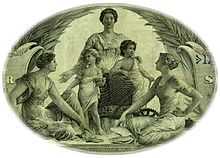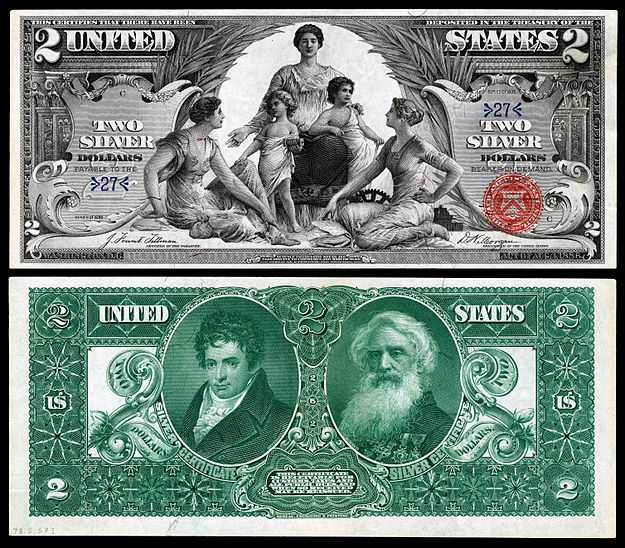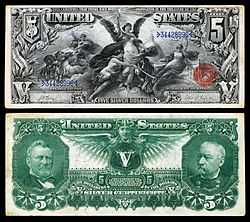Educational Series
| (United States) | |
|---|---|
| Value | $1, $2, $5 |
| Years of printing | 1896 |
| Estimated value | US$300 - $8,000 |
| Obverse | |
 | |
| Design | Closeup of the motif on the $2 note Science presents Steam and Electricity to Commerce and Manufacture. |
The Educational Series series of notes is the informal nickname given by numismatists to a series of United States silver certificates produced by the United States Treasury in 1896, after Bureau of Engraving and Printing chief Claude M. Johnson ordered a new currency design. The notes depict various allegorical motifs and are considered by some numismatists to be the most beautiful monetary designs ever produced by the United States.[1]
Design
The obverse of the notes depict a neoclassical allegorical motif, which dominates the front of the note. The motifs are meant as representations of the theme written on the note. The back contained the profiles of two American figures (usually famous Americans) set against an ornate background.
Denominations of $1, $2, and $5 were produced. In addition to $1, $2 and $5 notes denominations of $10, $20, $50, $100, $500 and $1000 were also planned. Designs for a $10 and $50 denomination were being prepared but were never completed or produced before the series was abandoned and replaced by the series of 1899.
The term "Educational" is derived from the title of the vignette on the $1 note, "History Instructing Youth".
Design and Production Credits
$1 "History instructing Youth"
Front Face Designer: Will H. Low
Engraver: Charles Schlecht
Rear Back Designer: Thomas F. Morris
George Washington Vignette Engraver: Alfred Sealey (1867)
Martha Washington Vignette Engraver: Charles Burt (1878)
$2 "Science presenting steam and electricity to Commerce and Manufacture"
Central Vignette Designer: Edwin H. Blashfield
Central Frame and Background Designer: Thomas F. Morris
Vignette Engraver: G. (George) F. C. Smillie
Border Engraver: Charles Schlecht
Rear Back Designer: Thomas F. Morris
Robert Fulton and Samuel F.B. Morse Vignette Engraver: Lorenzo J. Hatch
$5 "Electricity as the Dominant Force in the World"
Central Vignette Designer: Walter Shirlaw
Border Designer: Thomas F. Morris
Central Vignette Engraver: G. F. C. Smillie
Border Engraver: Thomas F. Morris
Rear Back Designer: Lorenzo J. Hatch and Thomas F. Morris
Rear Back Engraver: G. F. C. Smillie
Ulysses S. Grant and Phillip Sheridan Vignette Engraver: Lorenzo J. Hatch
Controversy
The naked breasts of the female figures on the $5 Silver Certificate reportedly caused some minor controversy when several Boston society ladies took offense to the design. Some bankers reportedly refused to accept the notes in transactions, and the term banned in Boston allegedly originates from the $5 Silver Certificate.[2][3] In response the Bureau of Engraving and Printing prepared a "draped" bosom $5 vignette design for a proposed 1897 series. The redesign also included a highly modified front face but was never utilized.
Also for the first time in 1893, Bureau authorities invited a small group outside artists and engravers to submit design proposals for the new series of notes. The presence of the outside group caused tremendous creative problems within the BEP. Great personality conflicts and jealousy could be one reason that although the $1 design was approved in July 1894 the remaining two notes were not accepted until late 1895. At one point during the process BEP designer Thomas Morris resigned. Coupled with being banned in Boston the notes were quickly replaced by the Series of 1899 notes.
Notes
| Educational Series | ||||||
|---|---|---|---|---|---|---|
| Image | Value | Dimensions | Description | |||
| Image | Allegorical Motif | Obverse | Reverse | |||
.jpg) |
$1 | Large-sized | History Instructing Youth | The Goddess History instructing a youth, pointing to a panoramic view of the Potomac River and Washington D.C. The Washington Monument and the US Capitol Building are visible in the background. The United States Constitution is displayed to the right. Circling the motif are the last names of famous Americans. Some of those listed are: (George) Washington, (Benjamin) Franklin, (Thomas) Jefferson, (Robert) Fulton, (Samuel F.B.) Morse, & (Ulysses S.) Grant. | Martha Washington, George Washington | |
 |
$2 | Science presents Steam and Electricity to Commerce and Manufacture | Science (center) presents Steam and Electricity (the two children) to the more mature figures of Commerce (left) and Manufacture (right). | Robert Fulton, Samuel F.B. Morse | ||
 |
$5 | Electricity as the Dominant Force in the World | Electricity surrounded by other allegorical figures, representing the dominant force in the world. The United States Capitol building can be seen behind the female figures. | Ulysses S. Grant, Philip Sheridan | ||
References
- ↑ A Guide Book Of United States Paper Money: Complete Source for History, Grading, and Prices pg. 27 "It is delightful to that the most beautiful designs, in the opinion of many, are those that were used on the smaller denominations..."
- ↑ A Guide Book Of United States Paper Money: Complete Source for History, Grading, and Prices pg. 106 "The uncovered bosoms of certain of the figures in the scene caused several Boston society ladies to rally against the design, and some banks to resist taking them - the origin of the term "banned in Boston."
- ↑ Federal Reserve Bank of San Francisco (2006-04-05). "American Currency Exhibit: Metal Standards - Showcase of Bills". Retrieved 2006-10-31.
4. Stacks Bowers Auction Catalog "The Harry W. Bass, Jr. Collection Part V", August 17, 2011
http://www.stacksbowers.com/auctions/auctionlots.aspx?auctionid=115&sessionid=212
External references
- A Guide Book Of United States Paper Money: Complete Source for History, Grading, and Prices by Arthur L. Friedberg (Compiler), Ira S. Friedberg (Compiler), and Q. David Bowers. ISBN 0-7948-1786-6
- FRBSF Currency Exhibit
Portions of this article used material from the Federal Reserve Bank of San Francisco website, which is in the public domain.